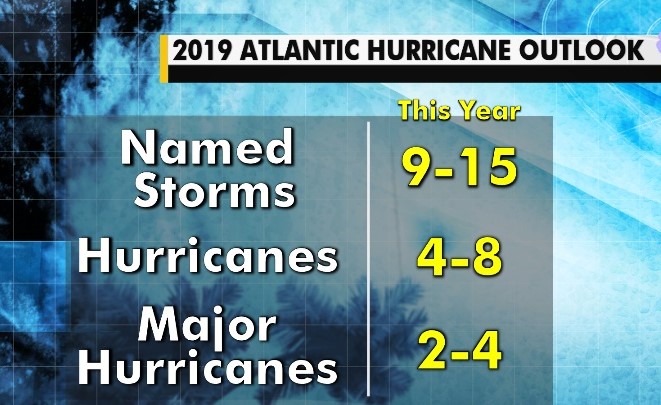MIAMI — NOAA’s Climate Prediction Center is predicting that a near-normal Atlantic hurricane season is most likely this year.
There is a 40 percent chance of a near-normal season, a 30 percent chance of an above-normal season and a 30 percent chance of a below-normal season.
For 2019, NOAA predicts a likely range of nine to 15 named storms (winds of 39 mph or higher), of which four to eight could become hurricanes (winds of 74 mph or higher), including two to four major hurricanes (category 3, 4 or 5; with winds of 111 mph or higher). NOAA provides these ranges with a 70 percent confidence. An average hurricane season produces 12 named storms, of which six become hurricanes, including three major hurricanes.
“New satellite data and other upgrades to products and services from NOAA enable a more Weather-Ready Nation by providing the public and decision makers with the information needed to take action before, during and after a hurricane,” said Neil Jacobs, Ph.D., acting NOAA administrator.
NOAA also announced three new initiatives. NOAA’s National Weather Service is making a planned upgrade to its Global Forecast System (GFS) flagship weather model – often called the American model – early in the 2019 hurricane season. This marks the first major upgrade to the dynamical core of the model in almost 40 years and will improve tropical cyclone track and intensity forecasts.
“NOAA is driving towards a community-based development program for future weather and climate modeling to deliver the very best forecasts, by leveraging new investments in research and working with the weather enterprise,” Jacobs said.
But Jordan Martirossian, a Geographic Information Systems (GIS) technician with Bartlett & West based in Fort Worth, Texas disagreed with Jacobs on Twitter.

“I feel that given the weak, struggling El Niño and warming Atlantic MDR, this 2019 hurricane season will overachieve (be stronger than predicted),” Martirossian wrote. “Wouldn’t be surprised to see 13-15 named storms, 6-9 hurricanes, 3-5 major hurricanes.”
MDR is a swath of the tropical Atlantic Ocean that stretches from Africa’s western coast to the Caribbean. In terms of Atlantic Sea Surface Temperature (SSTs) and their impacts on tropical waves, anomalously cool water effectively means less fuel for developing tropical cyclones.
NOAA’s National Hurricane Center and NWS office in San Juan will expand the coastal storm surge watches and warnings in 2019 to include Puerto Rico and the U.S. Virgin Islands. In addition, NHC will display excessive rainfall outlooks on its website, providing greater visibility of one of the most dangerous inland threats from hurricanes.
Also, this season, NOAA’s Hurricane Hunter aircraft will collect higher-resolution data from upgraded onboard radar systems. These enhanced observations will be transmitted in near-real time to hurricane specialists at the National Hurricane Center, the Central Pacific Hurricane Center and forecasters at NWS Weather Forecast Offices.
The Atlantic hurricane season begins June 1 and ends November 30.



